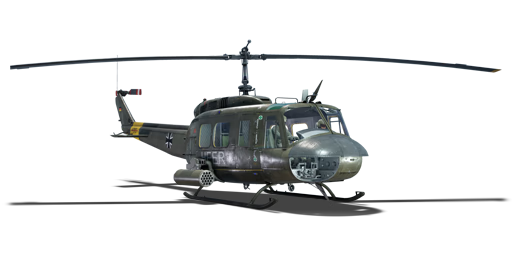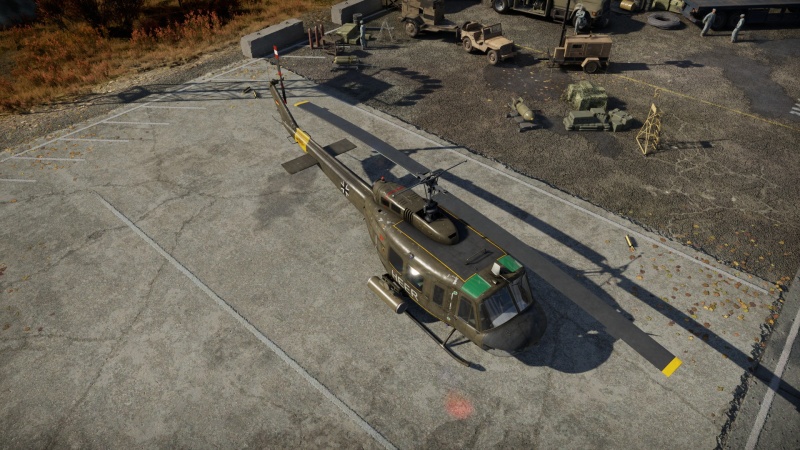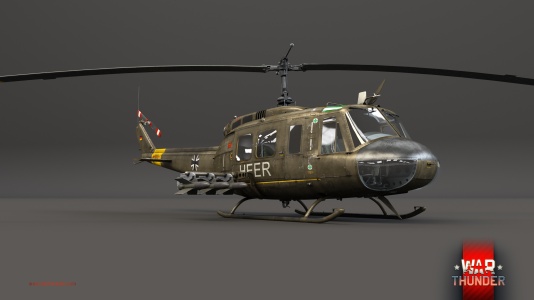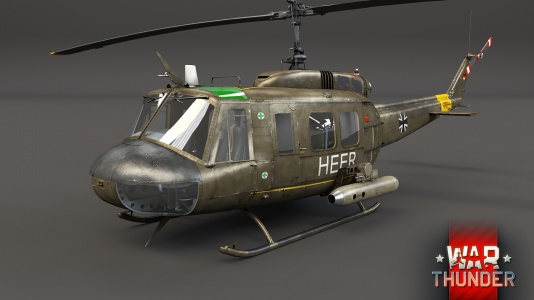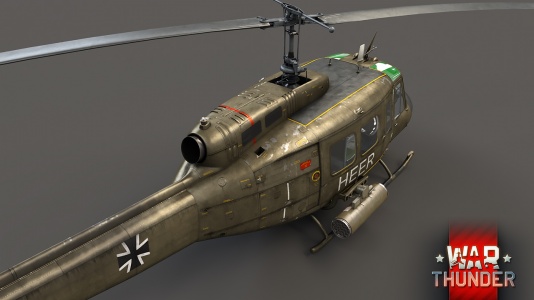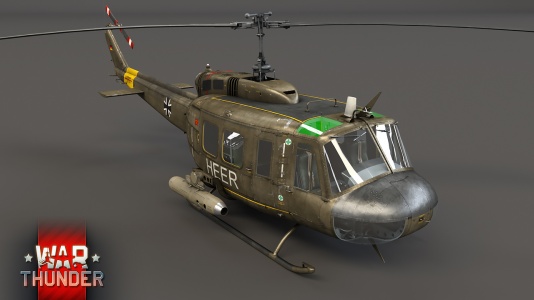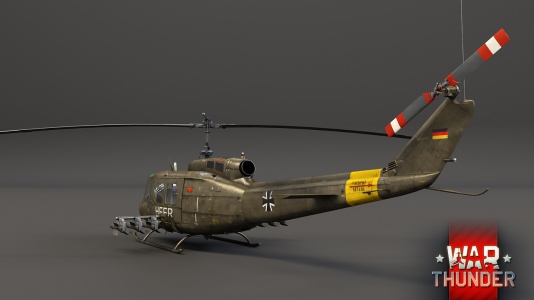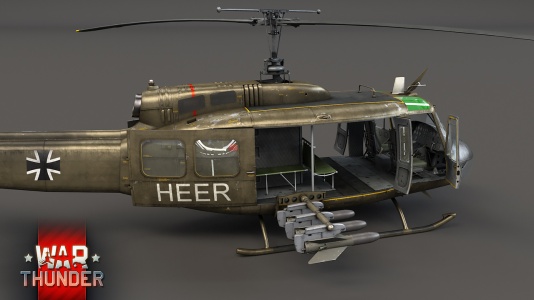UH-1D (Germany)
| This page is about the German utility helicopter UH-1D (Germany). For other uses, see UH-1 (Family). |
Contents
Description
The ◄UH-1D is a rank German utility helicopter with a battle rating of (AB), (RB), and (SB). It was introduced in Update 1.83 "Masters of the Sea". Icon of Vietnam war, this upgraded Huey utility helicopter built under license by german Dornier takes on its predecessors abilities and improves upon them in almost every way.
General info
Flight performance
▀UH-1D is a utility helicopter first and foremost.This means that it is not built for speed nor agility.
However, players must look at ▀UH-1D in context of its BR.
Compared to its contemporaries, such as Mi-4, it is surprisingly fast (with only AH-1G being faster), thanks to its powerful Lycoming T53-L-13 turboshaft engine.
Engine provides 1,300hp , making it the best performing engine in the Huey family. This allows the ▀UH-1D to reach speeds of almost 250km/h while in stock configuration.
It's climb rate is also very good for its BR, 15m/h when stock is twice as good as its predecessor and it even beats some older Mi-24 helicopters by 6m/s.
In regards to its agility, it is average. While it is heavier than its predecessor and certainly not agile enough to perform barrel roll, it's good enough to perform defensive maneuvers or lay its gun on targets.
| Characteristics | Max Speed (km/h at 0 m - at sea level) |
Max altitude (metres) | |
|---|---|---|---|
| AB | RB | ||
| Stock | ___ | ___ | |
| Upgraded | ___ | ___ | |
Survivability and armour
Being designed as a utility helicopter, ▀UH-1D does not enjoy any defensive measures commonly found on dedicated attack helicopters, thus its survivability remains below average.
There's no armor plating nor ballistic glass, and having only one engine, any damage to it can prove to be fatal.
▀UH-1D has only two crewmembers, sitting side by side in front of the helicopter. Due to the aforementioned lack of any armor or bulletproof glass, their survivability is quite poor.
▀UH-1D also has no defensive countermeasures found on modern helicopters. There are no flares nor IRCM, thus it is quite vulnerable to IR missiles. It also has no RWR (radar warning receiver) nor MAW (missile approach warning), relying purely on visual detection to detect incoming cannon fire and SAMs.
Modifications and economy
Players' main focus should be on getting an SS.11 upgrade. This unlocks the ability to carry up to 6(!)x missiles AS.11 ATGMs. Those dramatically increase not only ▀UH-1D survivability, but also effectiveness against armored targets. Thus it is preferable to start researching IL.68.22.I module first, as the player needs only one tier I module to progress and this module is a prerequisite for SS.11 upgrade. After that, it's up to the player what to research next.
Armaments
While ▀UH-1D can research NVD modification, players should be of note that Huey lacks dedicated built-in ATGM optics. This means only pilot gets access to NVD, drastically limiting Hueys effectiveness during night battles.
Huey also lacks a ballistic computer, making its unguided rockets somewhat inaccurate at longer distances.
Suspended armament
The UH-1D (Germany) can be outfitted with the following ordnance:
- 38 x FFAR Mighty Mouse rockets
- 44 x TDA rockets
- 2 x 7.62 mm M134 Minigun machine guns (1,500 rpg = 3,000 total)
- 6 x AS.11 missiles
FFAR Mighty Mouse rockets - stock arment available from the get go. They are launched in pairs and have up to 290mm of penetration. They are also slightly faster than TDA rockets and have slightly bigger explosive mass. Sadly their warhead is not powerful enough to cause indirect kills, meaning player needs to land a hit directly on the enemy tank in order to take him out.
TDA rockets - tier I upgrade, these rockets offer slightly better penetration at cost of speed and explosive mass. Huey is also able to carry 6x more when compared to Mighty Mouse rockets.
7.62 mm M134 Minigun - probably players best choice of weapon against other helicopters and planes. While having a high rate of fire, being of rifle caliber they present no threat to most ground vehicles (though they will decimate those few open top vehicles player may encounter).
AS.11 missiles - best weapon to deal with ground targets, ▀UH-1D can carry up to 6x of them. They are able to penetrate 600mm of armor at max. There are not many tanks on ▀UH-1D BR that carry reactive or composite armor, making them quite good. Their launch window is also huge, making the task of acquiring targets easier.
Usage in battles
As with any other helicopter, pilots should either adopt tactics of helicopter rush or sniping with ATGMs.
The longer the match goes on, the higher the chances of enemy AA appearing. This means players' chance to successfully employ helicopter rush tactics gets lower as the match drags on, making helicopter rush viable only in the early game.
From mid to late game, player might want to go with the tactic of sniping with ATGMs, picking off targets from maximum possible distance.
Helicopter rush
Recommended loadout: Mighty Mouse or TDA rockets
It is entirely up to the player's preference which unguided rockets he picks, as both perform rather similarly.
Tactics:
Even with better armored helicopters, using unguided rockets is always a gamble. Player needs to get close and personal with enemy ground vehicles - ▀UH-1D, lacking any sort of armor or countermeasures, is thus extremely vulnerable. Players success depends on whenever the enemy team has active AA. Thus it is better to helicopter rush at start of the battle rather than during, as there's smaller chance of enemy AA being present.
When helicopter rushing, player needs to approach the battlefield as low as possible, in order to avoid enemy radar and break line of sight by putting terrain, trees and structures between himself and the enemy. Players should select heliport spawn closer to the battlefield, and start approaching either enemy spawn or capture point; those areas have the highest chance of enemies being concentrated there.
Players should try to gain as much speed as possible before reaching their destination.
Once nearing 1 km distance from the objective, player should pull up and convert speed into attitude. While this will position player in the killzone of most dedicated AA vehicles in game, chances of those being active at the start of the match are low, and it will also position him to easily target roof armour of enemy vehicles, which is usually thin and not protected by ERA, allowing unguided rockets to slice right through it. Player should try to visually identify any AA vehicles and eliminate them first, as it increases his chance of survival.
While player can also attack similarly to the plane and fly ground level in order to avoid enemy AA, this tactic poses significant risk as most weapons carried by main battle tanks and IFVs can elevate high enough to target the player. Approaching helicopter will be heard before seen, as helicopters are loud, and more skilled players can determine helicopters direction from sound alone, allowing them to shoot helicopter down with machine guns and cannon fire as soon as it appears above the horizon. As ▀UH-1D lacks any armor, its survivability in this scenario is nearly non-existent.
ATGM snipping
Recommended loadout: 6x AS.11 missile
Having greater capacity than its predecessor, this payload in theory enables an accurate player to score 6 kills at maximum. Though player must be aware that AS.11 missiles are relatively slow and it might take time for them to reach their maximum range. Thus player should not waste their missiles at vehicles that are near cover as the enemy can leave his line of sight before the missile arrives.
Tactics:
Player should approach battlefield flying at low altitude, keeping distance of 3 km (maximum range of ATGMs). Bleed speed and start hovering. Finding any cover to hover behind and to break line of sight tremendously helps players survival - even trees can become extremely useful.
At ▀UH-1D BR, the biggest threat comes in the form of cannon SPAAGs, such as Shilkas. Those have the same range as ▀UH-1D missiles, thus it is vital to stay vigilant at all times. 3km range should give the player enough time to dodge if he spots enemy SPAAG firing in his direction soon enough. Sadly, it is possible to meet AA armed with SAMs when uptiered - those pose an even bigger threat than cannon armed SPAAGs, as they give player little to no time to react due to their speed and accuracy.
Pop above the cover for a few seconds, launch a missile or two, then go back. Change position, rinse and repeat. Player should stay around an altitude of 25 m when not engaging enemy tanks. Helicopter at this altitude confuses tracking radar and search radar might not detect them at all. Also, proximity fuze of SAMs is disabled below 25 m. If player is higher and he detects incoming fire or SAM, he should try to duck below 25 m as fast as possible. Direct hit can and will obliterate ▀UH-1D, but those are harder to pull off when dodging.
Staying in one place not only helps the enemy team to locate helicopter sooner, but some tanks with laser range finders might be able to shoot hovering helicopter down with tank guns at a range of several kilometres, since they present almost static target.
Planes and other helicopters also pose significant threat to player as ▀UH-1D cannot equip guns together with any missiles - if plane is spotted, player should consider retreating, either to closest airfield or in the vicinity of friendly AA. If an enemy helicopter is spotted, player may attempt to shoot it down with ATGM if its close enough, but due to their relatively slow speed, misses are to be expected.
Pros and cons
Pros:
- Able to carry 6 SS.11s ATGMs
- Able to carry unguided HEAT rockets with good penetration (which the predecessor Alouette II could not)
- Reasonably fast
- Very wide ATGM camera gimbal limits (110 degrees to each side horizontally and +10 to -70 vertically)
- Light weight allows helicopter to glide reasonably well, for a helicopter (glide ratio 4:1, 15° below horizon)
- Excellent joystick specific handling characteristics
Cons:
- Has a moderate tendency to nose over into an inverted dive
- Low redline speed (160 knots, 295 km/h),
- Helicopter is rather fat and long, therefore easy to hit
- Cannot equip any guns together with missile/rockets and the only gun modification allowed is the fixed M134 Minigun pods
- Night vision is essentially useless
- Lacks any sort of armor or countermeasures
History
The United States Army identified in 1952 a need for a new general utility helicopter which could also serve as medical evacuation (MEDEVAC) and instrument training helicopter too. The current inventory of helicopters had several flaws which the Army wanted to overcome including being too large, underpowered or extremely complex to maintain. The Army wanted a workhorse that was easy to maintain and have a fairly small profile. Twenty companies participated in the bidding process and in 1955, Bell Helicopter was selected to build three copies of the Model 204 for evaluation, and this version was designated XH-40 (Experimental Helicopter-40).
The XH-40 was built with the Lycoming YT52-L-1 (LTC1B-1) turbo engine helicopter, the first non-piston helicopter tested by the military and first flew in 1956. Even before the prototype had flown, the Army put in an order for six YH-40 service test aircraft in which they could field test to determine how it would work under military unit operations. Proving successful, Bell was awarded a contract to build another 100 helicopters which were designated HU-1A (Helicopter Utility-1A) and hence was officially named Iroquois. Iroquois ended up being a mouthful for people to say, so a nickname developed from the HU-1 designation which ended up being pronounced as Huey and stuck. In September 1962, the Department of Defense changed up the aircraft identification system to streamline between all of the different aircraft and their variations and changed the HU-1 to UH-1 (Utility Helicopter-1). Even with the change, the official Army name and the new DOD designation was rarely used as Huey was so well recognised as the name, that is what was to most people.
Unfortunately, with all of the positive feedback received for the YH-40, service tests performed by the Army found the T53-L-1A engine was found to be underpowered and could not perform to the level that was needed. Bell proposed to swap the T53-L-1A engine with the T53-L-5 engine, upping the shaft horsepower from 770 to 960 (570 kW to 720 kW) and extended the cabin to accommodate more people, up to 7 passengers or four stretchers and a medical attendant. The first production of the new helicopter UH-1B was delivered for service in 1961.
Several aerodynamic deficiencies of an armed UH-1B was explicitly identified not having enough engine power to lift the necessary weapons systems. The UH-1C was developed to overcome these problems by upgrading the helicopter with the T53-L-11 engine which had 1,100 shaft horsepower or 820 kW. The UH-1B helicopters which were in the service of the Army at the time were also upgraded with the new engine. Several adjustments were made to the UH-1C which included a new rotor-system, however, like many things which are upgraded, domino effect also requires other components and modules also to be updated. A larger diameter rotor was installed to counter blade stall during dives which required the tail boom to be extended and larger synchronized elevators to be added. While operating in military operations, it was determined necessary to add a redundant hydraulic control system to allow for continued operation in the event of a failure in one system. Larger fuel tanks allowed for further range with the total useful load capacity topping out at 4,673 lbs (2,120 kg). Mid-1966 saw the line production of the fully upgraded UH-1C helicopter.
Huey model 204 helicopters were a huge success and were put to use in several different capacities. However, the Army wanted another version which facilitated the carrying of more troops which spawned the Model 205. Bell adjusted by extending the HU-1B's fuselage by a total of 41 in (104 cm), boxed in the transmission and was able to add four more seats, two on each side of the transmission box facing out the side doors. With the side doors being easily removable, options to fly without doors made for quick loading and unloading of the helicopter which could now accommodate 15 persons, including the crew and could now hold six stretchers and a medic. First flown in 1961, the 205 took on many of the same upgrades as the UH-1C including the T53-L-11 which enabled usage of multiple types of fuel. Prototypes of this helicopter were designated YUH-1D, and the final assembly line aircraft was called the UH-1D.
This helicopter while still under evaluation the Army sent it to Vietnam in 1962 where it began operations. Initially only required as a general utility, MEDEVAC, and an instrument trainer, this helicopters role also expanded to include but not limited to air assault, cargo transport, search and rescue, electronic warfare and eventually ground attack.
During the Vietnam War, the UH-1 earned several other nicknames other than "Huey" which quickly identified to troops what role the helicopter had been outfitted for. Gunship versions of the UH-1s were identified as Frogs or Hogs if they carried rockets while if they just carried guns, they were identified as Cobras. Troop transport versions were called Slicks due to weapon pods being absent on the external pylons while they did retain their door gunners. Later in the war from 1967 to 1968, the gunship Huey's were replaced by the new AH-1 attack helicopters.
The success of the Iroquois helicopters did not go unnoticed by allies of the United States. When the USA released the UH-1D model, the West German government agreed to purchase a license to manufacture the latest Iroquois helicopters at German factories, particularly those of the Dornier company. Between February 1967 and the end of 1981, German aircraft manufacturers constructed 352 UH-1D helicopters.
Media
See also
Links to the articles on the War Thunder Wiki that you think will be useful for the reader, for example:
- reference to the series of the helicopter;
- links to approximate analogues of other nations and research trees.
External links
| Bell Aircraft Corporation | |
|---|---|
| Aircraft | |
| Fighters | P-39N-0 · P-39Q-5 |
| P-400 | |
| P-63A-10 · P-63A-5 · P-63C-5 · ␠Kingcobra | |
| Jet Fighters | P-59A |
| Export | ▂P-39K-1 · ▂Pokryshkin's P-39N-0 · ▂P-39Q-15 · ▄P-39Q-25 |
| ▂P-63A-5 · ▂P-63A-10 · ▂P-63C-5 · ▄P-63C-5 | |
| Helicopters | |
| Attack | AH-1F · AH-1G · AH-1Z · AH-1W |
| OH-58D | |
| Utility | UH-1B · UH-1C · UH-1C XM-30 |
| Export/Licensed | ▅UH-1B · ◄UH-1D |
| Tzefa A · Tzefa B · Tzefa D/E · ▅AH-1S early · ▅AH-1S · ▅AH-1S Kisarazu · ␗AH-1W | |
| ␗OH-58D | |
| See Also | Fuji Heavy Industries · Agusta |
| Germany helicopters | |
|---|---|
| Attack | |
| Hip | ◊Mi-8TB |
| Hind | ◊Mi-24P · ◄Mi-24P HFS 80 |
| Tiger | EC-665 Tiger UHT |
| Utility | |
| BO 105 | BO 105 CB-2 · BO 105 PAH-1 · BO 105 PAH-1A1 |
| Alouette | ◄SA 313B Alouette II |
| Huey | ◄UH-1D |


